Excerpted from “We Are Many: Reflections on Movement Strategy from Occupation to Liberation”;
Recently, on an Occupy listserv, I read about the Revoluyah’s, a nomadic group of Occupy artists and musicians. They refer to themselves as a “travelling joy committee” and are touring a boisterous road show to build alternative communities. One activist on the listserv responded to the tour announcement by saying “Well sure, but how are they gonna get corporate money out of politics?”
It is common to hear comments like this in many grassroots organizing settings where activists refuse to prioritize cultural work because they don’t see the point. And what is the point? What role do art and culture play in our lives? And what is the role of cultural resistance in a social movement?
Though some Occupy communities have been on the forefront of integrating effective cultural work into their movement activities, many still habitually separate art from activism, reducing the potential of art to mere decoration. Activists may have a healthy understanding that art can capture more mass media, that it can help get our stories out, and that it can bypass people’s intellectual filters to hit them on a deeper emotional level. But even then it is generally viewed as just another tool that can be picked up and put down again at will. This perception of art demonstrates a devastating misconception of the power and breadth of culture in our lives.
In this chapter I will offer three strategies for cultural resistance that allow us either to dismantle or to harness that power. To set the stage, it is first important to have a basic understanding of our modern culture so we can clearly see that when we are not using culture, it is using us.
Why Culture?
“The destiny of the world is determined less by the battles that are lost and won than by the stories it loves and believes in.” –Harold Goddard
“Culture” is a big term. It refers to the collection of expressions that make a society. In the world it is dance, music, art, fashion, language, food, etiquette, religion, mythology. In ourselves it is the stories we believe about who we are, what we can accomplish, our values, world views; it is the lens through which we interpret our realities. There are different cultures within a given society, but they often operate within a cultural hierarchy. A dominant culture wields the most power and sets the rules and standards of its society. Dominance is determined more by who holds the power over political and economic institutions than by who holds the majority.
The dominant culture in the United States was built from a foundation of European, English-speaking, Protestant Christian ancestry with strong white supremacist roots. Before the late 19th Century it promoted “thrift, modesty and moderation”, but as the Industrial Revolution took hold, major cultural shifts were put into motion that began changing the culture of the pious spendthrift into one of consumerism. As industrial production grew, droves of workers moved away from community-oriented small town life to alienating urban centers for factory jobs. While union organizing fought to raise wages and decrease the hours in a work day, the invention of mass production lowered costs of luxury items to be within the price range of workers. Credit was expanded to more people, making spending easier and more accessible to a larger population. Psychology gained popularity with an emphasis on the experience and fulfillment of the individual. Psychologists entered the field of advertising, ushering in a new era that used psychological theories (like behaviorism) to influence consumer decisions, creating “’lifestyle branding’—selling products by attracting consumers to a particular way of life rather than the good itself.”
Over just a few generations, consumerism became the predominant characteristic in our modern dominant culture; it is the driving force for much of our popular cultural output. We produce movies, shows, literature, theater, and advertisements that reinforce its cherished ideas through an endless and constant barrage of stories, images and sounds. We grow up understanding ourselves and our world through the frameworks these media provide. Even if we are raised into a subculture that rejects the dominant ideas and celebrates other standards, we still have to deal with the cultural ocean around us and its powerful tide that casts us against the rocks in spite of any countercultural life rafts in which we may try to stay afloat.
The impact of the dominant culture in our lives is undeniably hard to ignore. Even the most supportive parents will be hard-pressed to raise a girl without body issues when the culture holds up impossible Western European-based aesthetics as the standards for beauty. It’s common for people who are stuck in poverty though working multiple jobs to blame themselves when the culture promotes an American Dream myth that says everyone can achieve equally if they just work hard enough. We learn that time is money and money is power, that retail is therapy and that success is measured in acquired luxury goods.
These are the stories that rule our lives, that tell us who we are and who we should want to be, what we can achieve and how we’re supposed to fit in to the world around us. These are the stories that maintain our political and economic systems. Though not all of our dominant culture is begging for subversion, so many of its basic tenets, particularly when combined with consumer capitalism, are upholding institutions and systems that make some of our greatest values (like democracy, freedom and equality) impossible to achieve. On the other hand, within the dominant culture, music, religion, art, food and community traditions can provide healing, joy, strength and connection.
As activists, we must understand where culture has power over us and where it has power to support us. We must understand how culture has the strength to heal our wounds and grow our movements. Above all, we must take the time and make the effort to engage it. Cultural resistance is a central function of changing society. How can we shift any system of oppression if we don’t shift the culture that loyally believes in it?
Strategies for Cultural Resistance
“A people’s expressive culture, which is at the heart of its folklore, has a profound significance. It is a powerful statement of what is most deeply felt and of what gives meaning to people’s lives. If it flourishes, so too does their way of life.” –David Maybury-Lewis, Cultural Expression and Grassroots Development
If we understand how culture works as a force in our lives, then we can use that force to our advantage. It’s not a matter of simply adding music to an event or using a puppet at a rally, though that is certainly a part of it. We need to focus more broadly at developing larger cultural strategies. In the same way we design goals and strategies for our campaigns, we should be equally intentional about our approach to cultural work. Here I offer three primary strategies for cultural resistance that I identify as necessary to maintain an effective and enduring social movement.
To demonstrate each strategy, I use case studies from within the Occupy movement. Though someone could probably write a tome about the culture of our movement overall, I focus the case studies specifically on examples of how creative expression, the arts, have been used. I have had the great privilege of being involved in organizing a series of InterOccupy Arts Conference Calls, through which I learned about many of these efforts. The projects I’ve highlighted here I’ve chosen because they were particularly effective or innovative examples of a particular strategy (though they may in fact serve to fulfill multiple strategies). I am sure I am missing equally worthy projects and for that, I apologize. But I encourage all of you readers to find out more about what your Occupy community or other local arts activists have been doing in this realm.
And now, three strategies for cultural resistance:
1. Subvert, co-opt or reclaim the dominant culture.
To enact this strategy, we take the icons, images, stories, traditions of the dominant culture and alter them. (Think of the image of the ballerina on the Wall Street bull that helped incite OWS, the flashmobs using pop songs, the religious holiday services highlighting Occupy themes hosted at Occupy camps.) Using this strategy we can begin to take away or transform the power the dominant culture holds over us. We make visible the ways it manipulates our emotions and values, we interrupt it, we mock it, or we embrace its more powerful elements to push our messages.
As movement activists, our relationship to the dominant culture often has to be fluid. It’s a force too powerful to ignore completely. Deeply instilled behaviors, beliefs and power dynamics from the dominant culture tend to show themselves within our movement work whether we like it or not. There are some elements of the dominant culture that hold real personal value for people and thus hold potential to enrich and advance movements (i.e., religious traditions or popular music). While other elements limit human potential and are worth the effort to disrupt or subvert (i.e., religious traditions or beauty standards). The case studies included here explore both approaches to this cultural strategy.
Occupied Real Estate is an art activist project coming out of New York City, working around foreclosures, eviction defense and squatting. They have re-imagined the cultural construct of a real estate agency by creating their own that advertises abandoned properties for occupations, publicizes eviction defense, and promotes tools and tactics for successful squatting. Through a home renovation show on youtube teaching squatting skills, “real estate” brochures given to auction bidders advertising that the properties up for sale come with “500 protestors”, and the creation of eviction defense shields with life-size pictures of the families whose homes are being defended (creating a media spectacle when police smash through the picture-shields), they redefine the culture of “real estate” and its agents, co-opting its traditional imagery and showmanship to elevate their own values and movement tactics.
“For Squat” Signs. In a thematically similar vein, Occupy Minneapolis has been putting up “For Squat” signs on abandoned properties around their city. The signs are an exact imitation of traditional “For Sale” signs. Capitalizing on that easily recognizable image and the loaded symbology of a real estate sale, activists have set up a public challenge to the dominant culture surrounding the sanctity of private property.
Flashmob in Wells Fargo.
Using the popular Lady Gaga song, “Telephone”, San Francisco Pride At Work/HAVOQ activists organized a flashmob in the lobby of a Wells Fargo bank to highlight the bank’s role in the economic and housing crisis, turning it into a youtube video that advertised an upcoming Occupy day of action against banks. The protesters flooded the bank lobby with costumed dancers, jumping up on counters and doing a choreographed dance routine to rewritten lyrics of the Gaga song (featuring the line “Stop calling, stop calling, can’t afford to pay anymore/I left my head and my heart in the class war”).
Tax Dodgers Baseball Team is a fake baseball team that enacts live street theatre performances in satirical support of tax-dodging corporations. (Their slogan? “We go to bat for the 1%”.) A replicable street theater tactic reminiscent of Billionaires for Bush, the team targets real-life, high profile tax dodgers and shows up to their events and corporate headquarters as their biggest supporters. They organize real baseball games in which they invite community members to form the opposing team – the 99 %ers – and then change the rules, pay off the umpires and rig the game. Taking advantage of the deeply entrenched values attached to the sport, the Tax Dodgers loudly defy them with their corporate, money-focused, rule-breaking, un-sportsmanlike team character, creating a humorous media spectacle that effectively re-brands whomever they target as a Tax Dodger. A jersey and cap of the team has just been put on display at the National Baseball Hall of Fame in Cooperstown, NY.
Luminous Intervention. formed as an off-shoot of Occupy Baltimore, the Green Pants collective has been re-making spaces throughout Baltimore with large-scale, outdoor projections. They partner with community groups to identify locations and subject matter, supporting local struggles by bringing to light “the hidden histories, practices and envisioned futures” of Baltimore residents. Projecting onto buildings owned by corporate targets or in branded shopping districts, Green Pants has been able to interrupt business-as-usual, calling attention to invisibilized stories while calling out bad corporate actors, achieving both a form of subversion and reclamation of the dominant narratives operating in public space.
2. Build our own movement culture.
For this strategy, we develop our own ways of communicating, our own rituals, our own symbols, our own literature and music. This includes creating spaces for transformation; retraining and healing ourselves from damage done by the dominant culture and legacies of oppression. (Think General Assemblies; tents; Guy Fawkes masks; favorite chants; committees devoted to anti-racism, faith or healing). Using this strategy we build a sense of community, of unity, of shared values, an alternative world view, and a commitment to making the struggle for social justice an integrated part of our lives.
A movement culture develops whether we acknowledge it or not. The act of coming together repeatedly inevitably gives rise to some kind of group culture. To make it sustainable and long-term, we must be intentional about how it develops. Building our own movement culture is an act of re-making society as we want to live it. We make it for ourselves, we model it for others. We use it to sustain our communities, our families and ourselves for a long and ongoing struggle for justice.
Artists, designers, comedians, performers and other cultural workers have been contributing their skills to build a common language, a community identity, an intentional movement-based subculture that helps people connect, build relationships, create new traditions and art, and make the movement a way of life that reinforces our shared values. Creative expression is just one part of building a movement culture, but it is significant and can straddle many mediums.
The Occupy movement has given rise already to many projects oriented towards this cultural resistance strategy, but in my search for case studies, this is the strategy with the fewest examples. Perhaps this indicates that developing our own movement culture (with a heavy emphasis on building community) is a necessary focus moving forward.
IndigNación Newspaper is a Spanish-language media project affiliated with Occupy Wall Street. The group publishes a website and printed newspaper with news and analysis about the Occupy movement and other local, national and international issues and political struggles relevant to the Latino community. The group has also printed posters for massive mobilizations. They use the process of poster and newspaper distribution as an outreach tool to develop relationships with Latino business owners and community members, engaging in conversations about the ideas behind their project and the Occupy movement.
Occupy Town Square is an affinity group of Occupy Wall Street that organizes “mobile, daytime, pop-up occupations” in parks and public spaces around New York City. The occupations aim to reclaim the commons, creating temporary zones where people can re-imagine a society based on mutual aid. The Town Squares feature a kitchen offering free food, a library, teach-in’s, political discussions, music, art activities, guerilla installations, and local cultural groups. The Town Squares pop up in different neighborhoods, doing local outreach in advance to collaborate with neighborhood groups so that the Town Squares offer community-specific teach-ins, cultural presentations, and language access. The group also collaborates with many artists and art groups (like the OWS People’s Puppets who perform puppet shows with community themes and give workshops) to infuse each Town Square with a festive, joyful atmosphere.
Occupy Design maintains a website to connect graphic designers to Occupy activists, letting people freely add to and take graphics and posters from the site. They are engaged in “building a visual language for the 99%”, creating new symbols and images that represent and give power to Occupy issues and values.
Laughter Against the Machine is a touring stand-up comedy troupe dealing with the main themes of the Occupy movement. As “comedians for the 99%”, they allow activists to laugh at the powers they are fighting, thereby legitimizing dissenting viewpoints. By allowing activists to laugh at themselves, they help cement a feeling of being part of a broader movement community.
Occupy Comix is capturing the stories, dreams and struggles of the Occupy movement through comic books, repurposing that artistic genre to help develop an alternative culture made up of our stories and our values.
3. Use cultural elements to give power to our outreach, actions, events and other key strategic processes.
To actualize this strategy we turn actions into creative spectacles, we turn concerts into recruitment tools, we develop our own media to tell our stories, and we sustain participation in our strategy sessions with food or fun meeting rituals. (Think colorful posters, inspiring youtube videos, brass bands at demonstrations, weekly strategy brunches at OWS.)
Using this strategy we not only find different ways for people to participate in our campaigns, but we make our actions more visible, push our stories into the public eye, spread oppositional thought and discourse, grow our movement, and reinforce the first two cultural resistance strategies.
Just as a movement will not achieve lasting success without a compelling movement culture to give it heart, so too will it fizzle without some level of organizing strategy. Strategy, simply put, is a roadmap of how to get from Point A to Point B. It’s the plan of action undertaken to reach the goals of a campaign, an action or an entire movement. To enact our roadmap and build towards our goals, we educate ourselves and others, we share skills and resources, we do outreach and recruitment , and we mobilize for actions and events. Into these strategic spaces we can find endless opportunities to use culture.
Cultural elements can be used as educational tools within a workshop (showing films, creating skits, etc.), sparking greater levels of engagement and deeper discussion. Visuals, music and movement can multiply the effect of an action or event, prompting better media coverage and more energy and inspiration from participants. Supportive artists or art events can make a movement and the values for which it stands seem “cool”, helping gain new recruits and resources. And good strategic storytelling (whether through performance, newspapers, sermons, actions, etc.) can help shift the popular understanding of and sentiments toward an issue.
Creative expression in the service of targeted strategy has been common within the Occupy movement, as artists and cultural workers have joined in the planning of direct actions and campaign strategy. Here are a few examples:
May Day Posters. Leading up to the May Day 2012 Occupy actions, Occuprint (a group collecting global Occupy poster art and making it available to activists) worked with Occupy artists across the country to design a series of visually powerful posters calling for the planned General Strike. The collective distributed them to Occupy communities around the country where they were wheatpasted throughout cities.
Occupy Kabaret Street. As a cover action for a building occupation, the Puppet Underground collective organized a roving cabaret of music and puppet shows that taught about the history of occupations in DC. The final puppet show showed the history of the occupied building, during which a surprise banner-drop and announcement revealed the takeover. This provided education, media and an audience for a building occupation that had to remain secret until the moment of revelation. (Creative Resistance photo gallery)
Tent of Dreams. In response to new enforcement regulations about sleeping in Occupy K Street’s McPherson Square encampment, activists painted a giant tarp with constellations and labeled it as the “Tent of Dreams”, draping it over the large central statue of General McPherson to turn it into a gigantic tent. Other compelling visuals were made using the theme of “Let us sleep so we can dream” to create a narrative that would both challenge the police’s justification for enforcement and keep the public conversation grounded in the larger social justice issues that drove Occupy activists to stay at the camp.
Working Groups and Affinity Groups. Art and culture working groups and affinity groups have become a mainstay of Occupy communities and approach their movement work from different angles. Occupy Wall Street’s Art and Labor group and San Francisco’s Artists of the 99% have focused their work around the economic inequalities art workers face, organizing actions targeting art institutions and publishing zines exploring the issues. Other groups like the Occupy Wall Street People’s Puppets and the Rude Mechanical Orchestra have focused on supporting or organizing actions and events, and training more activists in artistic skill sets.
Foreclosure Song. Housing activists with Organizing for Occupation in NYC have successfully and repeatedly blocked auctions of foreclosed homes by singing. They turn out sizeable numbers to attend auctions which they disrupt with their own simple song (sung in harmonies) that asks “Listen Auctioneer, all the people here, we’re asking you to hold off the sales right now”. It has prevented the auctions from happening, inspired participating activists and garnered a lot of media on the issue.
“…It is important to note that in only a few cases is protest directed explicitly at the culture of capitalism itself. Rather, protesters select as objects of their protest groups or individuals who they hold individually responsible… In other words, rarely do social protest movements specifically attack the system that is the source of their distress; instead they focus on real or symbolic figures who, for them, embody their oppression.” –Richard H. Robbins, Global Problems and the Culture of Capitalism
The stories we live by, the values we hold, our creative expression, how we build community: this is the realm of culture. This is why we cannot rely on fact sheets, marches and manifestos alone. This is why we desperately need to recognize that culture has to be on the front lines of any resistance movement. Because whether we acknowledge it or not, culture is not just a piece of the battle, it is the very ground on which the battle is being fought. We have been so focused on the guns that keep firing at us—the student debt, the bank bailouts, mass incarceration, privatization, neo-colonialism, war–that we rarely take a moment to look at the landscape on which we stand. It is time we examine the hills and the holes of our battlefield and make some decisions about what terrain we actually want to be fighting on. Because right now the battle is still centered smack in the middle of the culture of capitalism, complete with individualist ideals and oppressive behaviors. The sooner we recognize this, the sooner we can determine both where we should dig our trenches and where we can find more fertile ground away from the bullets to build something new.
Janelle Treibitz is a political organizer and puppeteer based out of Washington, DC. She collaborates with social justice organizations and grassroots campaigns, supporting them to incorporate culture-based strategies and creative tactics into their work. She has collaborated on cultural organizing projects with local, national and international groups including the United Workers Association, Empower DC, School of the Americas Watch, Consultoria Tecnica Comunitaria’s Teatro Indigena, and others. She has worked as an organizer with the Fair Budget Coalition, Save Our Safety Net DC, and Organizing Neighborhood Equity DC (ONE DC) and has worked for many years with the Bread and Puppet Theater in Vermont. She is a contributor to the book We Are Many: Reflections on Movement Strategy from Occupation to Liberation (2012, AK Press). Contact Janelle at janellevyn@gmail.com.







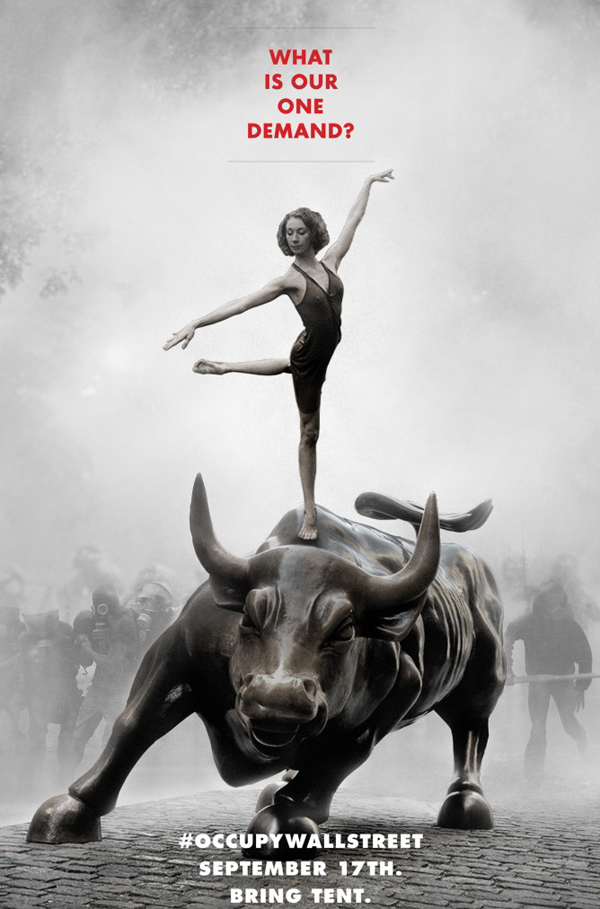
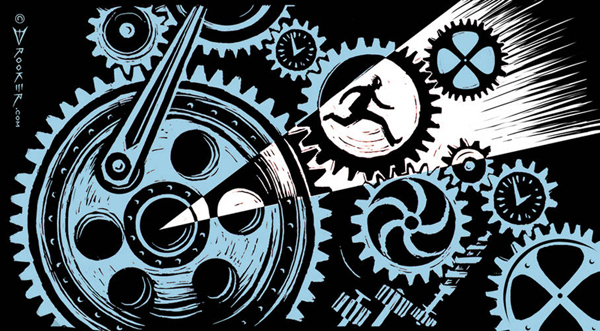

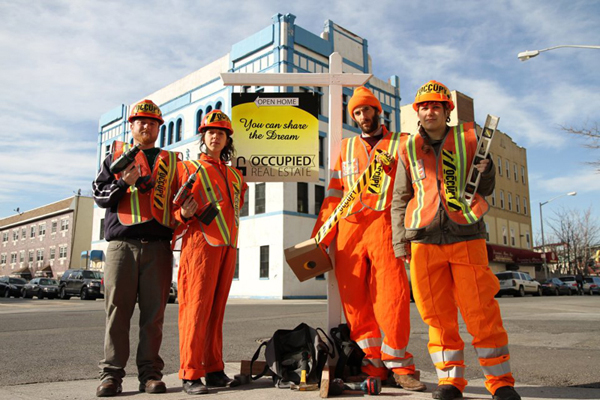
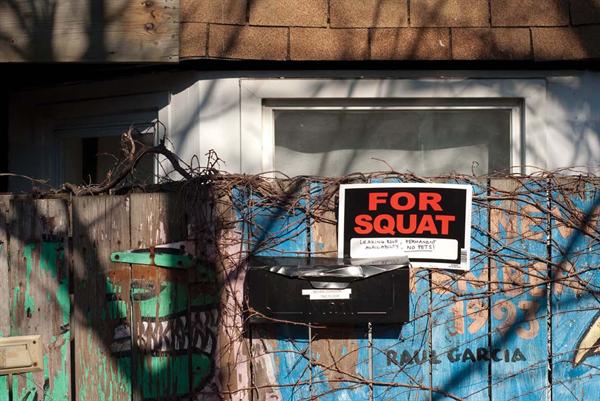
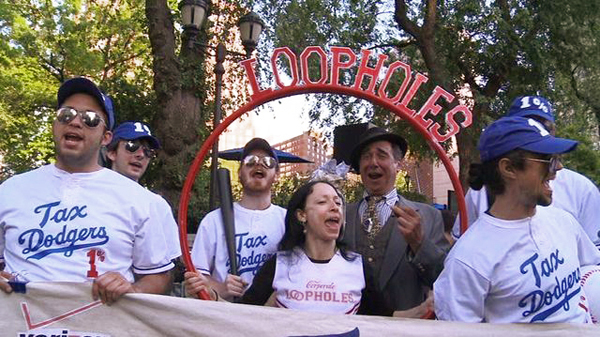
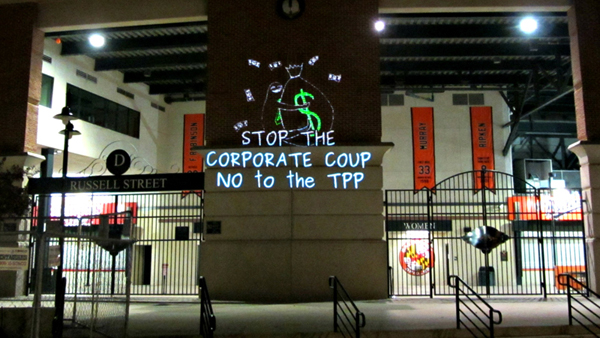
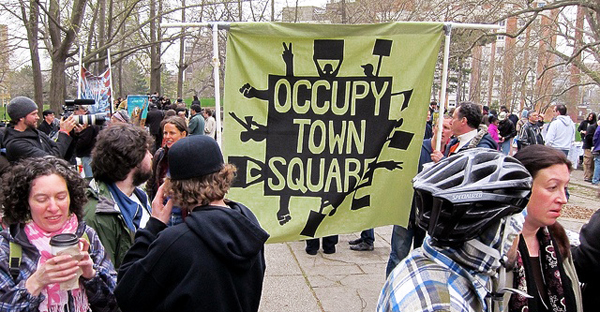
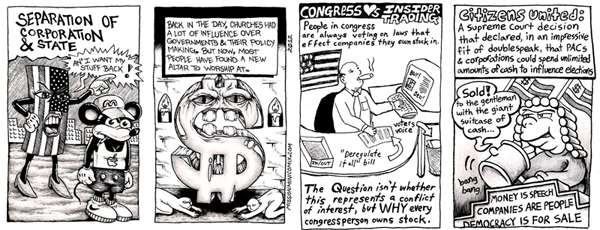
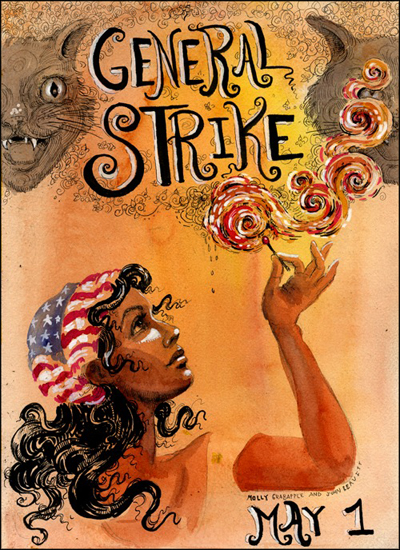
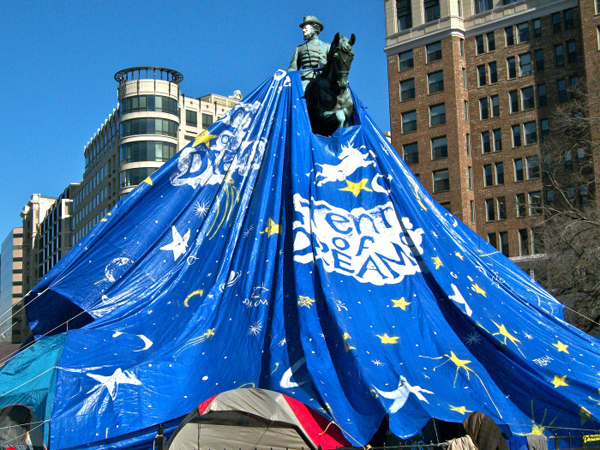
What’s up to every one, the contents present at this
web page are genuinely awesome for people knowledge,
well, keep up the good work fellows.
Wonderful resource. – thank you. Hopefully we will be able to add to share some of our own ‘creative resistance’ art.